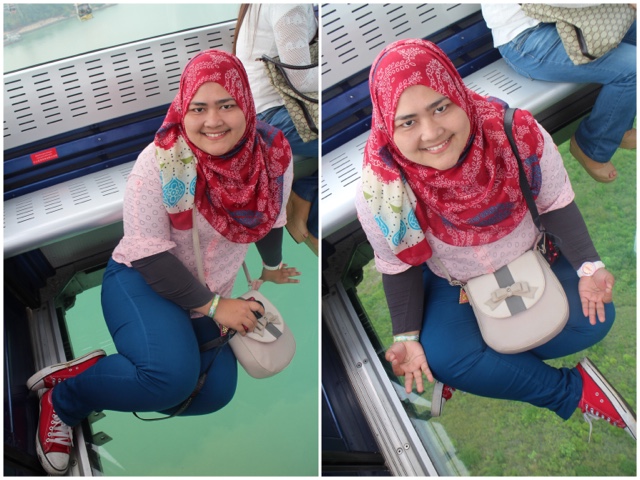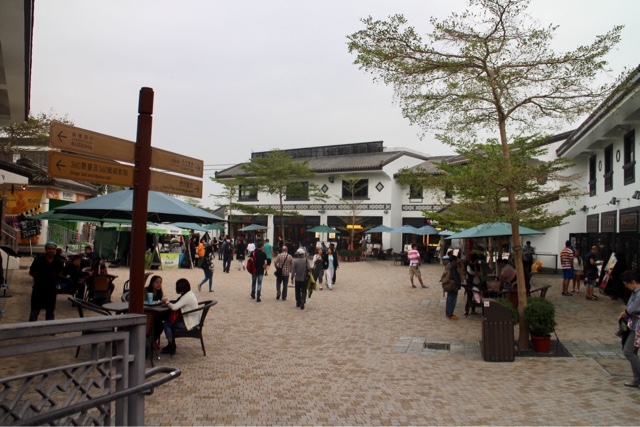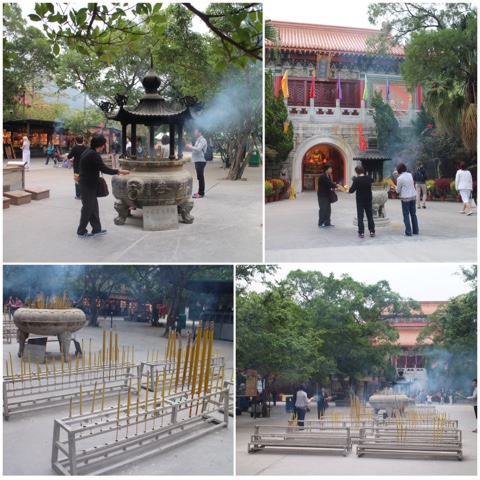Lantau Island with a land mass of 147.16km2, it is the sixth largest island in China and the largest island in Hong Kong, almost twice the size of Hong Kong Island. Originally the site of fishing villages, the island has been developed in recent years with the construction of Tung Chung New Town on its north-western coast and the completion of several major infrastructure projects, including Lantau Link (1997), Hong Kong International Airport (1998), Hong Kong Disneyland (2005) and Ngong Ping 360 (2006).
For this post however, the main focus is on our journey to Ngong Ping 360 which was our first itinerary for the 4th day at Hong Kong.
i) Ngong Ping, Lantau Island.
Ngong Ping is a highland in the western part of Lantau Island, Hong Kong. It hosts Po Lin Monastery and Tian Tan Buddha amidst the hills which is about 34 m tall. There are several hills nearby which are also an attraction to tourists. It is now the terminus of the cable car ride Ngong Ping 360 which travels to Tung Chung. New facilities and tourist attractions have opened including the Ngong Ping Village, Walking with the Buddha, Stage 360 and Ngong Ping Tea House. A youth hostel is located near the monastery. The second highest peak of Hong Kong, Lantau Peak, is at its southeast.
Direction :
It is easiest for most people to take the MTR (subway) to Tung Chung Station. Then take Exit B.
From there, you you have two choices to go up the Ngong Ping Village.
i) Cable Car - Walk about a block to the Ngong Ping 360 Cable Car Terminal (about 3mins walk)
ii) Bus - Take Bus 23 from the Bus Station below the Cable Car Terminal which takes around 45 minutes.
We started our day as ussual and went out from our Hostel after everything ready around 9.30am and took MTR from TST station to Tung Chung Station.
a) Ngong Ping 360 Cable Car.
Ngong Ping 360 = Ngong Ping plateau + 360-degree views. As one of the most unique attractions in Hong Kong, it comprises of a world’s top 10 amazing cable car ride and a culturally themed landscaped garden called Ngong Ping Village. Ngong Ping 360 Cable Car is a 25-minute scenic ride that connects Ngong Ping plateau with the town of Tung Chung. This hotspot of Hong Kong tourism is where you can feast your eyes with the panoramic vistas of Lantau Island and beyond, while enjoying quality time with your friends and family in a standard, crystal or private cabin. Do add it to your list of must do in Hong Kong.
Operation Hours
Open: 10am to 6pm for Weekday and 9am to 6.30pm for Weekends
Ticket
Price as per year 2017.
For Crystals Cabin at HK$255 Round trip / HK$180 Single trip
For Standard Cabin at HK$185 Round trip / HK130 Single trip
OR 1+1 Round Trip Cabin (1 way Standard Cabin + 1 way Crystal Cabin) at HK$240
We reached the Cable Station and saw a long line already formed at the ticket counter. Even though we arrived here quite early around 10am, ticketing queues were still quite long. There is a special line for people with advance purchase tickets to exchange vouchers for wrist bands to ride the cable car.
If your budget permits, we highly recommended for the glass bottom cable car, called a Crystal Cabin. You will feel like floating right on the The South China Sea, roads and the hills. It's definitely something different and thrill. We took the 1 way Crystal Cabin to Ngong Ping and 1 way Standard Cabin returned to experience both.
After receiving wrist bands, there’s a queue to enter the cable car. The glass bottom cable car queue was significantly shorter than the regular cable car. Then finally our turn came...
LET'S GO!
On board the cable cabin. We were like so "jakun" inside the cabin. We screamed, laughed, sat on the glass floor with trembling feet, took photo with shaking hands... over exited I must say. I think the other occupants on that cable car probably annoyed with our behaviour as they seemed to be rather cool and rilex :P
And the 25 minutes fly by where we finally reached the Ngong Ping Village.
b) Ngong Ping Village
Ngong Ping Village is a fabricated village that is more a coagulate of shops and eateries that leads to Tian Tan Buddha and Po Lin Monastery. This amazing cultural themed village has been architecturally designed & landscaped to reflect the cultural & spiritual integrity of the Ngong Ping area. In addition to exciting on-site shopping, dining and recreational facilities, Ngong Ping Village also hosts festive and themed events to entertain individual, group or family visitors alike. Treat yourself to a 5D movie at “Motion 360” or a multi-media journey at “Walking with Buddha”.
As the Ngong Ping location up the hill, the weather was quite cold here. I was shaking slightly which got nothing to do with the cable car experience before. It was the low temperature here and the wind also. So I recommend to wear a light sweater or jacket when coming to visit here.
c) Stage 360
Hong Kong has one of the largest and most dynamic film entertainment industries in the world and as for that, you can see movie influences in everywhere you go around Hong Kong including here in Ngong Ping. The new attraction has been added here which is the Stage 360, where visitor will be taking behind the scenes of a classic Hong Kong action movie. Guest will be able to watch stuntmen perform classic action sequences from famous Hong Kong films and even get to enjoy the high-energy action first hand.
We had a few props here and there to take photo with.
Lights, Camera, Action!!
Thinking about food. Don't worry as there is one Halal restaurant here. Just find Ebeneezer's Kebab & Pizzeria at the Ngong Ping Village.
As this place is also considered sacred and holy place with the Buddha and monastery, obviously you might see a lots of monk probably from other countries also visited here.
d) Walking With Buddha
Walking with Buddha in Ngong Ping 360 is an immersive, multimedia attraction that allows visitors to follow the life of Siddhartha Gautama, the man who became Buddha and his path to enlightenment. The Tian Tan Buddha and Po Lin Monastery on Lantau Island are built to commemorate him.
We didn't watch the show however we went to the souvenir shop next to it to see what in store. Basically the fridge magnet here is a bit expansive about RM10/piece but since it is beautifull, not a normal ceramic but rubber made and dedicated specifically for Ngong Ping, I bought one for my collection.
e) Bodhi Wishing Shrine.
One of the more famous points inside the village could jolly well be this wishing shrine. The Bodhi Tree, known as the Bo Tree, is the “Tree of Awakening”. It was the tree under which Siddhartha meditated “Who am I and why am I here?”, eventually attaining Enlightenment and becoming Buddha.
There is a legend saying that wishes made at the “Bodhi Wishing Shrine” under the Bodhi Tree will come true so if you are a believer and superstitious, you can make a wish at the Bodhi Wishing Shrine.
There were cable cars from all over the countries been displayed here and it's quite interesting to see the line of cable cars with different colours and shapes.
Ngong Ping 360 has a lot of attractions you can explore and you need at least a whole day in order to visit them all. Our itinerary only gives us just half day to explore so we had to manage our time carefully. We only explore the village for about 30 minutes and then headed to the where the Big Buddha is sitting. On the way there, you will walk through the Ngong Ping Piazza.
f) Ngong Ping Piazza.
The piazza is a long stretch of walkway where the Po Lin Monastery sits at the other end. Entering the gate to the square which leads to the Monastery and Big Buddha.
There were also line of souvenir and food stalls along the way.
g) Twelve Divine Generals.
You might think that it's just a walkway with a perfect view of the Big Buddha and the clear skies, but you are wrong. Lined up along the path to the Po Lin Monastery & the Big Buddha in Ngong Ping are the statues of the Twelve Divine Generals or the Twelve Heavenly Generals. They are the protective deities of the Buddha of Healing or the Medicine Buddha, Yakishi Nyurai. They originated in India, but in other countries they are believed to be the attendants of an Armor-clad God or Warrior that protects the righteous.
In Chinese, these twelve Generals represent the animals in their Zodiac. They are also considered as the common guards of the gates in Buddhist Temple. Maybe that's why they are lined up as soon as you enter the arch to the Po Lin Monastery and Big Buddha.
As there are twelve, I only took photo with The General Mihira as he represented Rooster, my Chinese Zodiac :D
We continued our walk until it lead us to the highlight of the Ngong Ping.... I presented to you the one and only..TIAN TAN BUDHHA.
h) Tian Tan Buddha
The Tian Tan Buddha symbolizes 6 characteristics and virtues of generosity, morality, patience, zeal, meditation and wisdom. Standing Sitting tall at 112 ft high and weighing 250 metric tons, the Tian Tan Buddha is the largest outdoor sitting Buddha in the world.
The statues is built on top of the Mount Muk Yuen and visitors have to climb 268 steps in orders to reach the Buddha. It symbolizes the stability of Hong Kong, prosperity of China and peace on Earth. The Big Buddha is so big that it can be seen across the bay as far as Macau on a clear day.
The Tian Tan Buddha statue sits on a lotus throne on top of a three-platform altar, appears serene and dignified, is symbolises the harmonious relationship between man and nature, people and religion. The Buddha right hand is raised, representing the removal of affliction and left hand rests on his lap in a gesture of giving dhana. Buddha surrounded by six smaller bronze statues known as “The Offering of the Six Devas” and are posed offering flowers, incense, lamp, ointment, fruit, and music to the Buddha. These offerings symbolize charity, morality, patience, zeal, meditation, and wisdom, all of which are necessary to enter into nirvana.
The Buddha faces north, which is unique among all the great giant Buddha statues, as all others face south.
As we thought it's better to take a view of the Tian Tan Buddha just from the ground, we just strolled around the piazza and proceeded our walk to the Po Lin Monastery.
Coming from the path from Big Buddha, you will be greeted by the large triple arch white stone gateway pai lau, its the Monastery's called the Mountain Gate. The Pailau is adorned with three pagoda statues on top and lion's head statues. It leads to a wide path lined with Bauhinia (flowering plants), the national emblem of Hong Kong.
i) Po Lin Monastery.
Po Lin Monastery is another popular attraction in Ngong Ping 360 in Lantau Island, Hong Kong. A visit at the themed village is not complete without visiting the Monastery. The Po Lin Monastery was founded in 1906 by three monks visiting from Jiangsu and was initially known as “The Big Hut”. It was renamed to its present name in 1924. The main temple houses 3 bronze statues of the Buddha representing his past, present and future lives as well as many Buddhist scriptures.
The monastery is considered as the most important Buddhist venue place of worship by the locals and is a rich and colourfull portrayal of Buddhism. The monastery has just finished restoration and looks gorgeously shining for the inner halls.
Although it's full of thorny bushes, and it's difficulty to access, it's very tranquil and serine - very ideal for a religious practice. Before it became the Big Thatched Hut, it was used to be a small stone house. The monastery became known and attracts a lot of monks over the years.
The monastery's popularity was gained when the Big Buddha was erected in 1993 and was dubbed the "Buddhist World in the South". It has become a practice of people that after visiting the Big Buddha they go directly to the Po Lin Monastery or the other way around.
j) The Wisdom Path
Another famous attraction in Lantau Island is The Wisdom Path. From Po Lin Monastery, follow sign to Tea Garden entrance and walk along the hiking trail among the forest for about 15 mins.
When you reach the destination, you will be in awe. At least I was. 38 wooden carvings, upright, containing verses from centuries-old Heart Sutra - one of the best well known prayers believed by Buddhists, Taoists and Confucians alike, in a '8' shape representing infinity ∞.
Very amazing.
It’s a chance to see a green side of Hong Kong as you round the corner from a touristy area to a path covered by a canopy of trees. It’s peaceful, beautiful and nothing like the Hong Kong skyline.
The Sutra is displayed in wooden pillars placed in the form of infinite figure which symbolize the immeasurable splendor and infinity.There is nothing grand about the place, but because of its ambience and serenity, it’s very peaceful to walk through.
We met one lady who was doing a photoshoot for a magazine to promote. She posed a few martial-art moves and the way she made it was so smooth and easy. With Ngong Ping hill in the background, it was really a good shots!
When we thought we had enough, we headed back to the Ngong Ping Village and to Cable Car terminal to get back to the city and have lunch. It was nearly 3pm but I didn't feel that long because I really enjoyed my visit here. On of my favourite place in Hong Kong, definitely!!
Back to the Ngong Ping Village.
If there's a line when we came, it's quite the same on the way back which we on the wrong time to be encountered with a group of older citizens from mainland China.
Luckily the queue was not too long and within minutes, we were back to the cable car (this time standard type cable) back to the Tung Chung Station.
So that was it. Almost half a day spent at Ngong Ping but definitely worth it. Never imagined this place has so much to offer. My first impression that it is only for religious purpose was definitely an understatement. Don't forget to include this in your itinerary when you come to visit Hong Kong as whether you are a cultural, religious or recreational tourist, you will always find something for you here.
Till then to be continued....
Trip to HK, Macau and Shenzhen Fast Link Here
Preparation
Day 0 – Departure to Hong Kong and First Night at Chungking Mansion
Day 1 – Star Ferry Ride from Kowloon to HK Island
Day 1 – HKCEC and Golden Bauhinia Square
Day 1 – Repulse Bay and Stanley Village
Day 1 – Lunch at Islamic Muslim Centre, Ammar Mosque and Tram Ride
Day 1 – The Mid Level Escalator
Day 1 – The Peak Tram and Night at Victoria Peak (Sky Terrace 428)
Day 1 – End of Day 1
MACAU Day Trip
Day 2 – Journey to Macau by TurboJET Ferry
Day 2 – The Venetian, Macao
Day 2 – City Of Dreams and Hard Rock Hotel
Day 2 – The Galaxy Macau
Day 2 – Grand Lisboa and Senado Square
Day 2 – The Ruins of St. Paul’s
Day 2 – Macau back to Hong Kong
Shenzhen Day Trip
Day 3 – Starting Journey to Shenzhen, China from Hong Kong
Day 3 – Window of The World
Day 3 – Shopping at Shenzhen and back to Hong Kong
Hong Kong Trip Continues
Day 4 – Aberdeen Floating Village and Jumbo Kingdom
Day 5 – Disneyland Part 1
Day 5 – Disneyland Part 2
Day 5 – Disneyland Part 3
Day 5 – Shopping at Ladies Market, Mongkok
Last Day – Avenue of Star
Last Day – HK Museums, 1881 Heritage and Back to Malaysia
Total Expenses








































































No comments:
Post a Comment